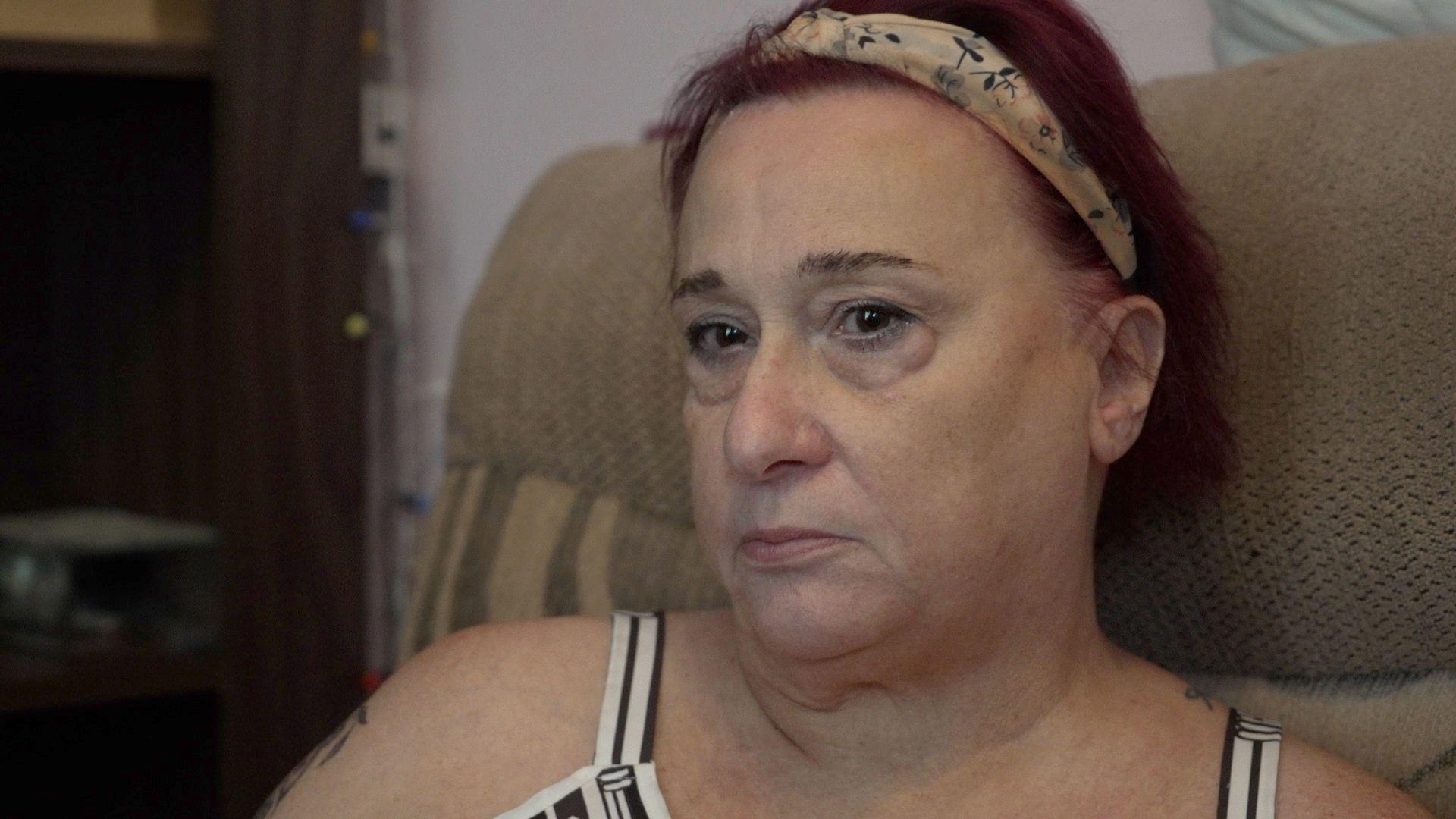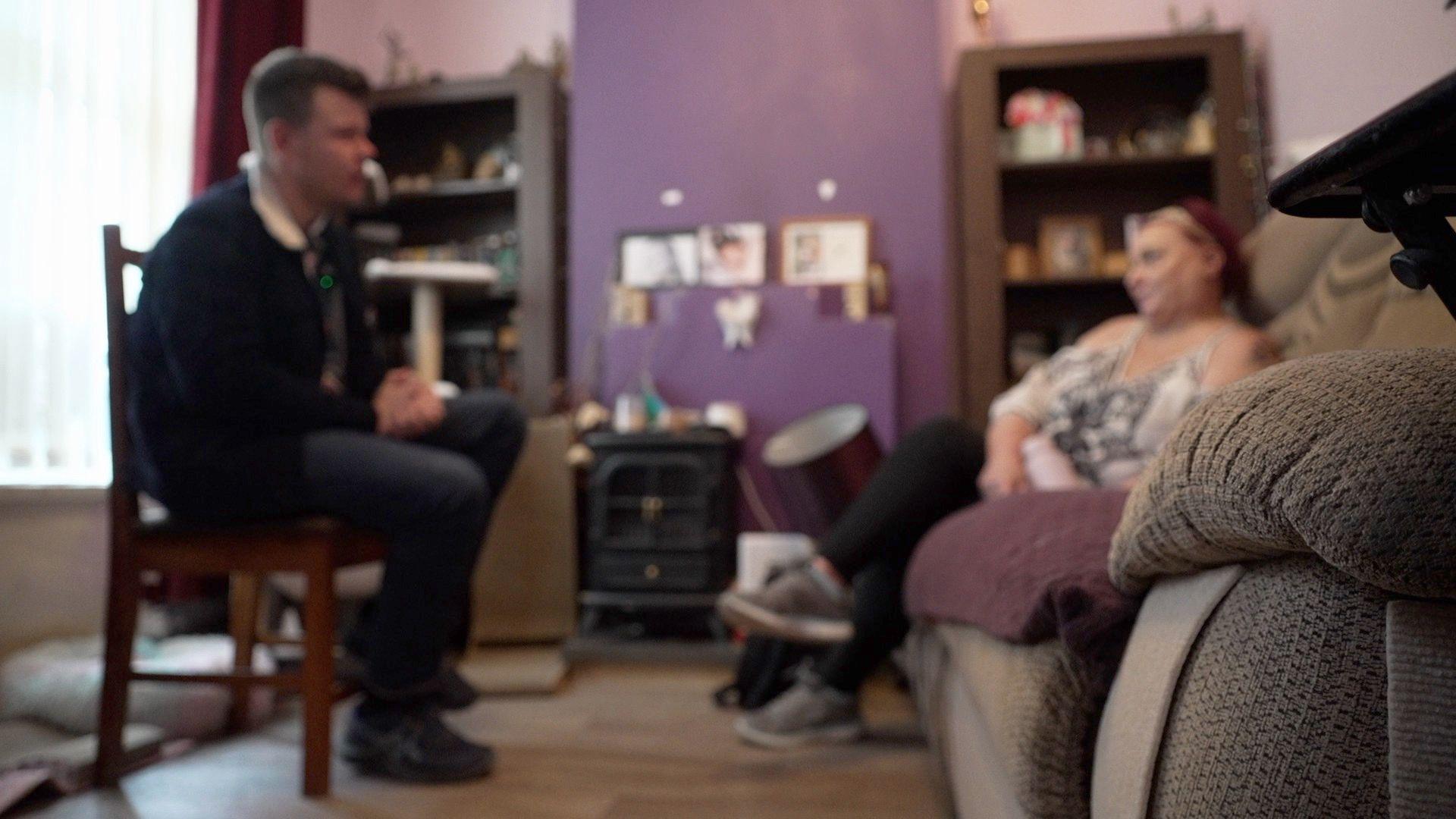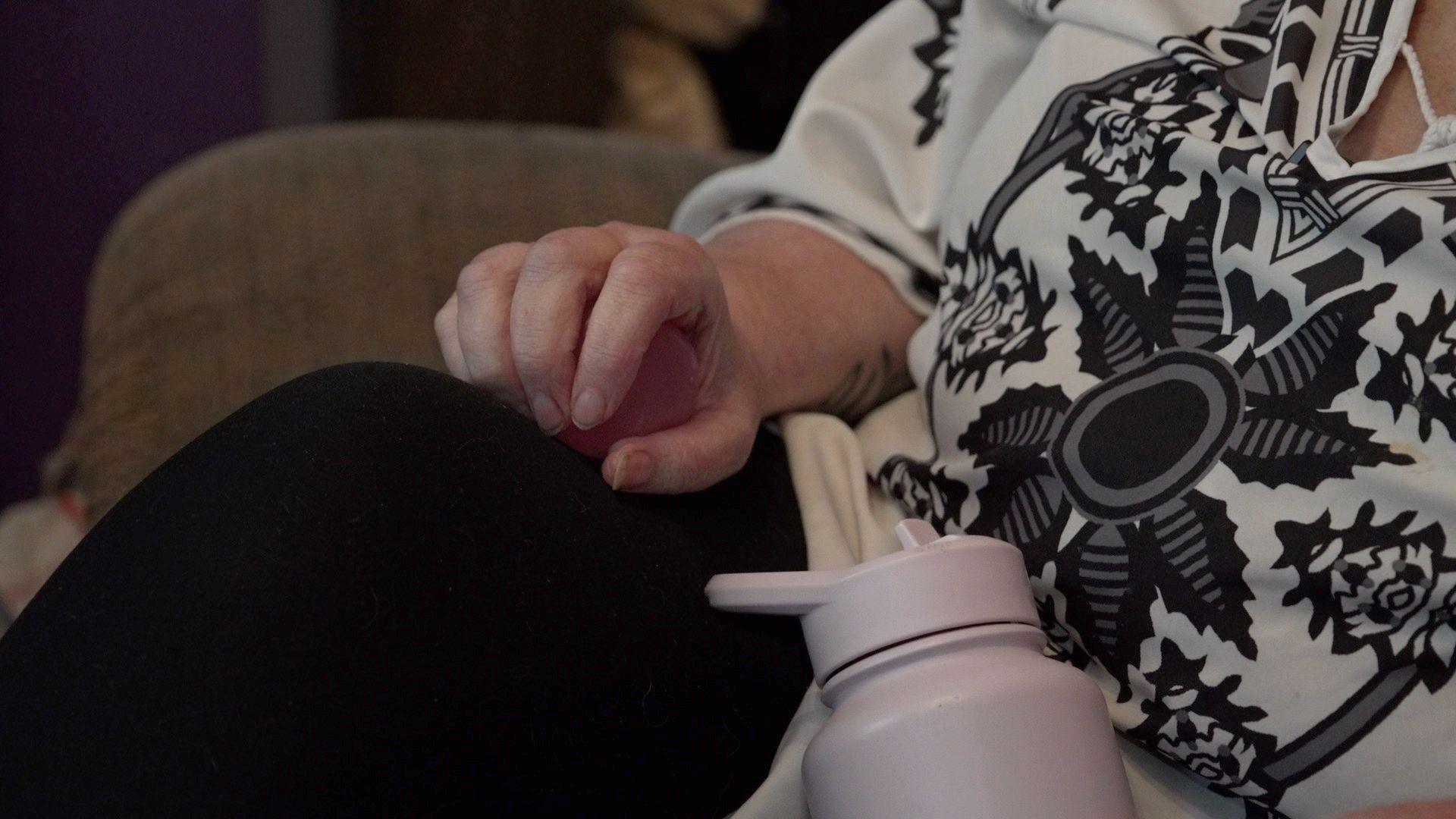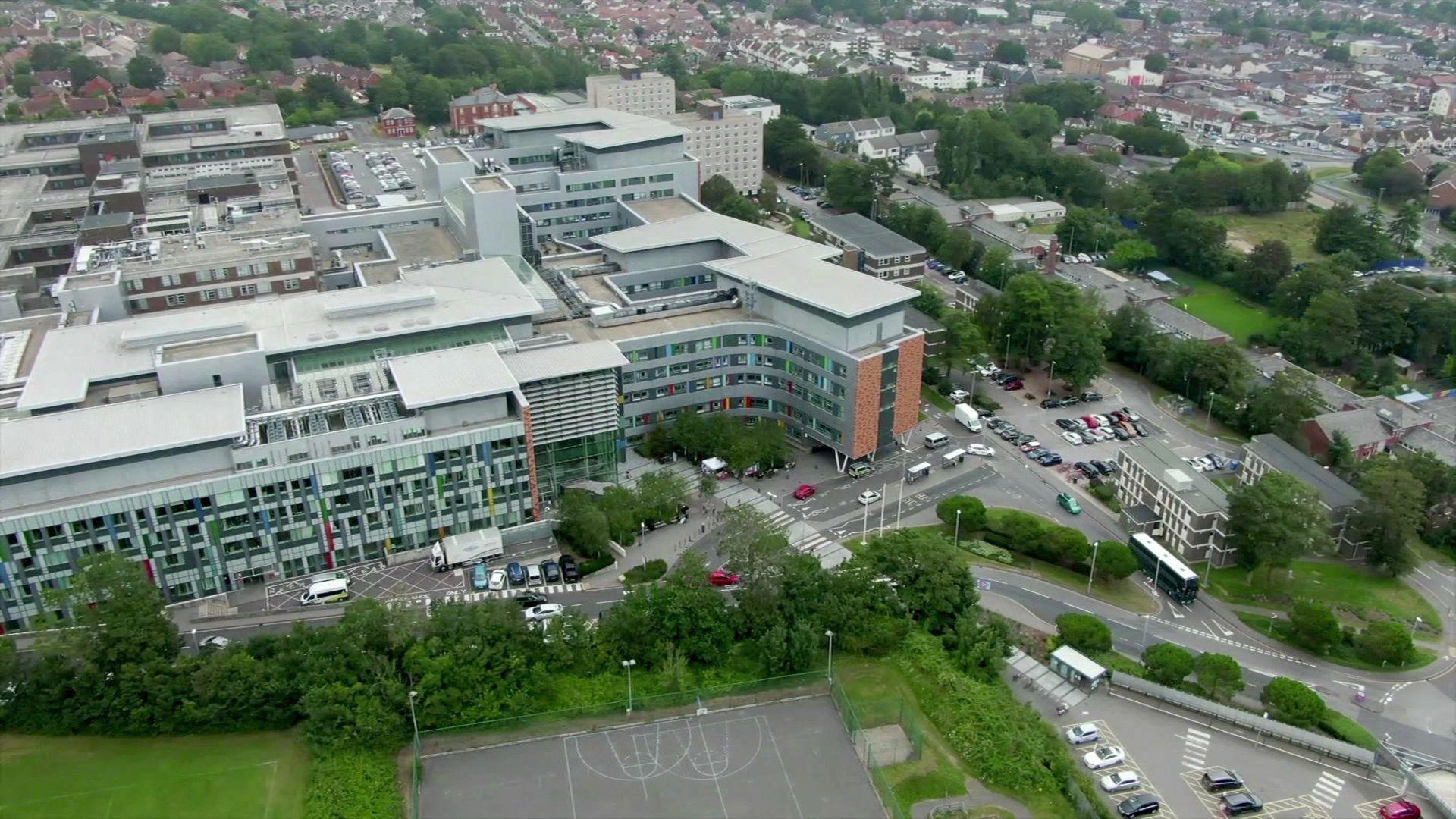Woman waits nine hours in A&E for sepsis treatment

Lorraine Hedges said that she was left traumatised after a nine-hour wait left her in convulsions
- Published
A woman has said she was left "traumatised" after having to wait in a hospital corridor for more than nine hours before being treated for sepsis.
Lorraine Hedges from Portsmouth, Hampshire said she believed that Queen Alexandra (QA) hospital had put her at risk, despite paramedics warning hospital staff that she could have the life-threatening condition.
An expert from charity UK Sepsis Trust said that someone with the condition should never wait more than three hours without treatment with antibiotics.
QA Hospital has apologised to Mrs Hedges, saying it was not the standard of care patients rightly expect. It said it was investigating and would share its findings with the family.

Lorraine shared her experience with BBC South during an interview at her home
Lorraine said she became unwell at home during the night in August, shortly after an operation to remove a kidney stone at the QA hospital in Portsmouth.
"I was being very violently sick in the night," she said. "But I said, 'I'm not going to ring the hospital, I'm just going to go to sleep'."
But after she threw up six times in a row, her daughter Kelly came over and phoned the NHS 111 service.
About eight minutes later, Lorraine said, an ambulance turned up at the door.
"[The paramedic] did tell me at that point that he suspected sepsis," she said.
Lorraine said she had arrived at A&E at QA hospital at around 16:00 BST, where she said paramedics told hospital staff they suspected she had sepsis.
But despite that, Lorraine claims she did not have any observations taken - things like her temperature and heart rate - until four and a half hours later, at 20:30.
In the meantime, she said, she was lying on a trolley in the corridor.
"I was in so much pain, and nobody asked me how I was," she said. "And I felt so ill that I just wasn't communicating."
Lorraine said it was not until her daughter told staff her urine was the colour of cola that observations were taken.
At 23:00, seven hours after arriving, she said a staff member confirmed she had sepsis.
BBC South has seen a sick note written by Lorraine's GP which confirms a sepsis diagnosis.

Lorraine said her experience had left her with newfound anxiety, leaving her unable to leave the house
Shortly after midnight, Lorraine said her daughter stepped out to call other family members and update them.
Lorraine said her daughter told her that when she came back, she had found the bed in the middle of the corridor with no screens around it and that Lorraine had been "fitting and screaming for [her] mum".
In the end, Lorraine said she waited nine and half hours before receiving antibiotics, at around 01:30.
"If I didn't have Kelly with me at the time, I really believe I wouldn't be here now," she said. "I would've been lying there and god knows what would have happened."
Her daughter has since put in a complaint on her behalf, and Lorraine said the experience had left her with newfound anxiety and a distrust of the hospital.
"I felt like I was gonna die, I felt so traumatised, terrified to go back to hospital," she said.
"To be honest, I feel really let down by them," she said. "I feel like they put me at risk. And I feel like there's no accountability, at all."
"I want answers from them," she added.
Nine hours in a hospital corridor with sepsis
Dr Natalie Borman, chief medical officer at QA Hospital, said: "We are sorry to Mrs Hedges and her family for their experience in our Emergency Department as this is not the standard of care our patients rightly expect."
She confirmed they had received a complaint from Mrs Hedges' family and were investigating the concerns they had raised. She said they would share the findings of their investigation with the family.
Dr Borman added: "Our teams are working hard to improve the experience our patients have when using our emergency department, including waiting times. This includes introducing new patient pathways to ensure patients receive the care they need in the right place in a timely way."

Dr Ron Daniels, founder of the UK Sepsis Trust, said that someone with sepsis should never wait more than three hours to be treated with antibiotics
Dr Ron Daniels, founder and chief medical officer of the charity UK Sepsis Trust, said the maximum time that someone with sepsis should wait for treatment was three hours.
He said a lack of highly skilled staff and a higher demand on services meant the way sepsis was treated needed a rethink.
"On the face of it, this story sounds horrific," he said. "This was a person with a major risk factor for sepsis, having just had an operation."
He added: "Every day we hear stories where the diagnosis of sepsis is delayed, or people have failed to be heard properly.
"A delay of many hours is simply not acceptable - and can impact on whether someone survives."

Queen Alexandra hospital, part of PHU NHS Trust, have improved A&E waiting times over the last year
The operational standard for A&E waiting times is that 95% of patients should be admitted, transferred or discharged within four hours of their arrival at an A&E department. The national average is currently around 75% for England.
At Portsmouth Hospitals University NHS Trust, around 72.6% of patients met this standard in September 2025 - a 10% improvement since last year.
The most recent assessment by Care Quality Commission in May 2025 rated the urgent and emergency services at the QA hospital as "requires improvement," but noted an improvement from the previous inspection.
The report states: "There were not always safe and effective systems to identify and assess risks to the health, safety and welfare of people who used the service."
The overall rating of PHU NHS Trust was "good".
What is sepsis?
Sepsis is a life-threatening condition where the body's response to an infection damages its own organs and tissues.
It is relatively common, with around 245,000 cases per year in the UK, according to charity Sepsis Trust.
If not treated early, sepsis can turn into septic shock and cause organs to fail.
Guidance from the NHS website says that treatment for sepsis should be provided as quickly as possible.